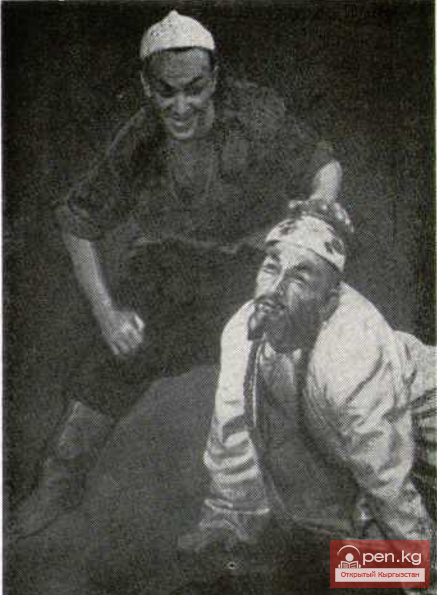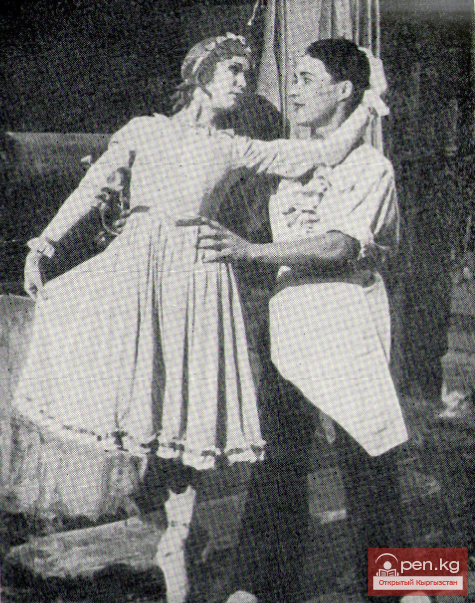Honored Artist of the Kyrgyz SSR B. Suslov.
L. A. Zhukov, who staged the ballet "Red Poppy" by R. Glière following "Swan Lake," entrusted B. Suslov with the role of Captain. Naturally, this static, non-dancing role could not captivate B. Suslov: Ma Lichen — that was the role to play! But what can you do....
The new choreographer of the theater, I. K. Kovtunov, soon staged a second version of "Red Poppy," and then B. Suslov began to dance Ma Lichen. Once again, he experienced the joy of creative collaboration with B. Beishenaliev, who performed the role of Tao-Hoa in this production.
Suslov as Ma Lichen is brave and simple; he is a faithful son of his people. The artist performed the role energetically and passionately. He executed airborne jumps, both simple and delayed, with extraordinary ease. Once, Boris was first appreciated by his teacher K. A. Afanasyev. And he was not mistaken... Over the years, B. Suslov honed the beauty of his jump.
The performance of the young artist in the role of Ma Lichen did not go unnoticed. He was talked about in the press. This was a well-deserved reward for the great effort of the artist, who spent hours polishing every movement, every seemingly insignificant detail of the role.
In 1955, B. Suslov was entrusted with the role of Phoebus in "Esmeralda." The controversial role of Phoebus forced the artist to seek a performance line that would justify the hero's actions. Indeed, the frivolous aristocrat becomes an accuser of feudal society — this may seem an implausible stretch. B. Suslov showed that his sympathies for Esmeralda were stronger than for his bride, the aristocrat. This interpretation was more consistent with the finale, where Phoebus appears at the head of the rebellious crowd that comes to free Esmeralda.
In the new role, B. Suslov performed complex dance variations. Countless turns and jumps showcased the artist's growing mastery. At the same time, he remained remarkably tactful in the duet, not overshadowing his partner, skillfully mastering the art of support.
A year after his performance in "Esmeralda," B. Suslov performed the role of Prince Desire (ballet "Sleeping Beauty"), alternating it with Uran Sarbagishov. The captivating, inspired image of Desire, seeking true love, is full of deep emotions. This is how B. Suslov presents him to us. This feeling permeates, for example, the adagio of Desire and Aurora in the scene of love confession. B. Suslov particularly expressed the emotional conclusion of the role — the solo variation that conveys exuberant joy. In this role, B. Suslov once again proved himself to be an impeccable dancer of classical style.
For two years (1956–1957), B. Suslov worked on new roles in national ballets ("Spring in Ala-Too" and "Anar"). He already had experience working in national productions. He performed the role of Nurdin ("Cholpon") and now expanded his repertoire with the roles of Asan and Bugrov in the ballet "Spring in Ala-Too," and Bagysh in "Anar."
The new roles were sharply divided into positive and negative characters. While in the role of Asan, the artist highlighted a lyrical-romantic line, in Bugrov, he emphasized a heroic one, whereas his Bagysh is a characteristic type. B. Suslov does not hide the external negative traits of Bagysh, sometimes even resorting to some pressure, as if to emphasize that cruelty and inhumanity prevail in him.
The artist sought to evoke unfriendly feelings in the audience towards his hero, so that his demise would be perceived as deserved retribution.
In the ballet "Romeo and Juliet," Suslov performed the role of Tybalt. A hero of another era, environment, and conditions, Tybalt bears some resemblance to Bagysh. He is even unattractive in appearance, this red-haired Tybalt, symbolizing medieval chivalry. B. Suslov follows the musical characterization given by the composer S. Prokofiev. His appearance is accompanied by ominous music; its harsh sound intensifies as the tragic conclusion approaches. In the third scene of the second act, sharp musical rhythms unexpectedly burst into the folk festivities in the streets of Verona. Something threatening is heard in them at the moment when Tybalt draws his sword to deliver a fatal blow to Mercutio. The battle theme sounds again in the orchestra, and Tybalt falls, struck himself.
Gloomy chords sound, reminiscent of the tragic scene in the ballet "Anar" — the demise of Bagysh in the swift flow of a waterfall.
Performances in various roles ensured B. Suslov a solid success as a soloist of the Kyrgyz Ballet Theater. No new production was complete without the participation of Boris Suslov, both in classical and national repertoire.
In 1962, Boris Vasilyevich Suslov was awarded the honorary title of Honored Artist of the Kyrgyz SSR.
Boris Vasilyevich Suslov













































